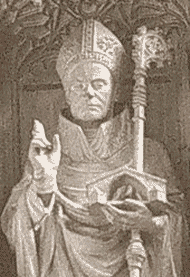|
Saint
Swithun
Swithun was famous for his charitable gifts and for
building churches and bridges. On the Great Screen in Winchester
Cathedral you can see a nineteenth century statue of the saint, which
shows him holding a bridge in his hands. Surviving documents show that Swithun was involved
in decisions and reforms of great significance, not only to the Church
but to English land-law as well. The legislation which set aside tithes
(a tenth of all lands) for the upkeep of the Church and its
ministrations dates back to Swithun's time. The very act (854) has
Swithun's signature on it, along with that of king Ethelwulf and his son
Alfred. Swithun died 2 July 862. He was buried in the
cemetery, just outside the west door of the Old Minster. After Ethelwold
became bishop of Winchester (964) and introduced monks to form the first
monastic cathedral chapter in England, Swithun's relics were translated
into the cathedral. This took place 15 July 971. The occasion was marked
by many cures claimed as miraculous, and heavy rainfall, believed to be
yet another manifestation of St Swithun's power. Even today it is often
said that if it rains on St Swithun's day it will rain also for the
following forty days. St
Swithin's day, gif ye do rain, The translation was carried out as part of extensive building operations which included enlarging the Old Minster westwards, making Swithun's original tomb the centre of a "shrine-church" with transepts on either side. After the Normans built a new cathedral at Winchester, Swithun's body was translated into it in 1093. His shrine remained a popular goal for pilgrims throughout the Middle Ages. |
 Swithun
was born about AD 800. He was educated at the Old Minster in Winchester.
Egbert, king of Wessex 802-39, chose Swithun as his chaplain and
entrusted him with the education of Ethelwulf, who became king in 839.
In 852 Ethelwulf made Swithun bishop of Winchester. During Swithun's ten
years' episcopate Wessex became the most important kingdom of England.
At the same time came the first attacks by Vikings in the south of
England.
Swithun
was born about AD 800. He was educated at the Old Minster in Winchester.
Egbert, king of Wessex 802-39, chose Swithun as his chaplain and
entrusted him with the education of Ethelwulf, who became king in 839.
In 852 Ethelwulf made Swithun bishop of Winchester. During Swithun's ten
years' episcopate Wessex became the most important kingdom of England.
At the same time came the first attacks by Vikings in the south of
England.